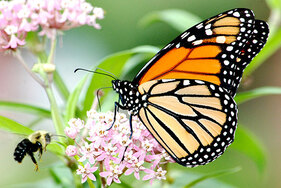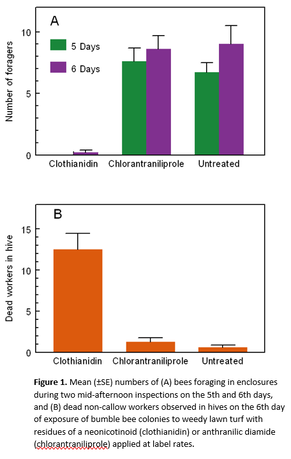 Written by: Margaret Hartman (M.S. student, Lamp Lab) and Demian Nunez (M.S. student, Hooks Lab) In recent years the public has become increasingly aware of the devastating impact humans are having on wildlife across the globe. Insect declines have received a lot of attention in the news lately with stories about the decline of pollinators inspiring people across the country to find ways to “save the bees,” including planting flowers in their yards, and some state and local governments are even taking steps to restrict or ban certain pesticides that are known to be harmful to pollinators. While honeybees (Apis mellifera) are among the most recognizable and charismatic of these pollinators, the real crisis is the even greater loss of native pollinator abundance and diversity across much of North America and other parts of the world. But pesticide usage isn’t the only factor contributing to the loss of our native bees and other insects. Diseases, parasites, and especially habitat loss have all contributed to native bee decline, and efforts to maintain and restore the health of our pollinator ecosystems will require a broad approach to making our expanding urban landscapes suitable for preserving our pollinator communities. Dr. Daniel Potter at the University of Kentucky has dedicated much of his career to applying ecological principles in developing sustainable pest management practices. His recent work has looked at ecotoxicology and landscape ecology as they relate to urban pollinator conservation, including investigating alternative chemicals and practices to reduce the threat neonicotinoids pose for pollinators. Neonicotinoids are a class of insecticides often used systemically (though they can be sprayed) to control plant sucking, chewing, and boring insects in many urban and ornamental settings. Their advantages include being cheap and easy to apply, and often only requiring a single treatment in a season. However, neonicotinoids are the class of insecticides that the public usually associates with pollinator decline, especially after a catastrophic misapplication in Wilsonville, Oregon in 2013 resulted in the deaths of 50,000 bumblebees across 300 colonies. Dr. Potter’s research has looked into best management practices to reduce the impact neonicotinoids have on pollinators when they are used, as well as investigating pollinator-friendly alternatives. A common use for neonicotinoids in urban settings is grub control in lawns, which poses a hazard to bees foraging in the white clover that often comes up in people’s yards. Dr. Potter’s lab conducted a study comparing a neonicotinoid with chlorantraniliprole, a newer equally effective anthranilic diamide insecticide (Figure 1, Figure 2), which uses a different mode of action to kill pests, and their impacts on commercially purchased bumble bee colonies. Replicating industry standard practices for timing and applications of the chemicals, Potter introduced the colonies to their respective plots a day after application and noted greatly reduced foraging within the neonicotinoid-treated turf (Figure 1A). He also found that hives foraging on nicotinoid-treated weedy turf were more likely to have dead workers than hives foraging on weedy turf treated with the non-neonicotinoid alternative (Figure 1B). Six days after the hives were placed in the yard, they were moved to a horse farm free of pesticides to be weighed and have their reproduction evaluated. Potter also mowed the treatment lawns after he removed the original colonies to see if such a practice would reduce colony effects, and ten days after the initial treatment he added new colonies. He found that there was a 99% reduction in pesticide contamination, and an elimination of colony level effects across all treatments. The results of his work were one of the factors that compelled Scotts, a large manufacturer of consumer lawn care formulations, to replace neonicotinoids in its grub control products with the more bee-friendly anthranilic diamide (chlorantraniliprole) that Dr. Potter used in his study. Chlorantraniliprole has a high safety margin for both bees and vertebrates because of target site insensitivity in those groups. There is currently a movement throughout the US and other countries to build pollinator gardens with plants preferentially visited by bees. Potter’s lab conducted a large-scale survey of bee species in the Ohio valley tri-state area to develop recommendations for bee-attractive flowering trees and shrubs which can provide thousands of blossoms apiece. He emphasized that different tree species were more attractive to different bee species assemblages and that native trees were not always clearly better for promoting species diversity and richness. He also noted that the quality of a tree as a food source was not dictated by the plant’s regional origin. A real concern about non-native tree species, however, is their potential to act as a stepping-stone for promoting non-native, potentially invasive bee species. In addition to bees, Dr. Potter also studies monarch butterfly (Danaus plexippus) conservation in urban habitats. The monarch’s conspicuous black, orange and white coloring, large size and famous long-distance migration make them a highly coveted backyard visitor. Unfortunately, monarchs seem to be threatened by habitat loss, specifically the loss of milkweed through agricultural and horticultural practices. The monarch caterpillar’s host plant is milkweed (Asclepias spp.), of which there are around 40 species in North America. Milkweed is an obligatory host for monarch caterpillars, which means it must eat milkweed to survive into adulthood, however, it is not well-known which species they prefer in mixed-plant garden settings. Dr. Potter and his team set out to answer this question. Potter’s research concludes that placing the larger milkweed species on the perimeter of a garden where the monarchs can pick up their visual and chemical cues increases monarch reproductive activity. Using this information to design your milkweed garden ensures monarchs will visit you frequently. Educating the public about these conservation issues is a subject Dr. Potter is enthusiastic about. He uses charismatic entomofauna such as the monarch butterfly and bumblebees as drivers for conservation and change. Visit Dr. Potter’s lab website to learn more about the exciting research he and his students are conducting. Citations Baker AM, Potter DA (2008). Colonization and usage of eight milkweed (Asclepias) species by monarch butterflies and bees in urban garden settings. Journal of Insect Conservation 22 (3-4): 405-418. Larson JL, Redmond CT, Potter DA (2013) Assessing Insecticide Hazard to Bumble Bees Foraging on Flowering Weeds in Treated Lawns. PLoS ONE 8(6): e66375. https://doi.org/10.1371/journal.pone.0066375 Mach BM, Potter DA (2018) Quantifying bee assemblages and attractiveness of flowering woody landscape plants for urban pollinator conservation. PLoS ONE 13(12): e0208428. https://doi.org/10.1371/journal.pone.0208428 Authors Margaret Hartman is a first year M.S. student in the Lamp Lab. She studies the application of Odonata, specifically damselflies, as biological control agents in enclosed systems such as greenhouses and aquaponics. Demian Nunez is a first year M.S. student in the Hooks Lab. He studies the potential biocontrol benefits of intercropping row crops with perennial ground cover in order to increase the natural abundance of ground predators such as wolf spiders. Comments are closed.
|
Categories
All
Archives
June 2024
|
Department of Entomology
University of Maryland
4112 Plant Sciences Building
College Park, MD 20742-4454
USA
Telephone: 301.405.3911
Fax: 301.314.9290
University of Maryland
4112 Plant Sciences Building
College Park, MD 20742-4454
USA
Telephone: 301.405.3911
Fax: 301.314.9290



 RSS Feed
RSS Feed




